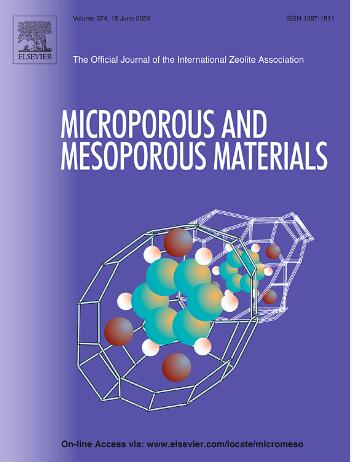Effect of low-temperature ozonation-assisted detemplation on the properties and catalytic performance of Sn-Beta zeolite
IF 4.8
3区 材料科学
Q1 CHEMISTRY, APPLIED
引用次数: 0
Abstract
Sn-Beta is a good Lewis acid catalyst. Typically, the organic template in as-made Sn-Beta was removed by calcination in air atmosphere at high temperature (≥500 °C). The fast combustion of organic template in air would lead that the actual temperature of sample is out of control, which will result in the partial disintegration of framework Sn species that are the active centers for catalytic reactions. In this work, ozonization at mild conditions (≤200 °C) was used to remove the organic template. It was found that the ozonization temperature greatly affected the template removal. The template removal efficiency reached 89 % at 120 °C for 3 h. The ozonized Sn-Beta has more framework Sn sites than Sn-Beta-C, for which the template was removed by traditional calcination route. However, the ozonized Sn-Beta showed slightly poor performance for conversion of glucose to methyl lactate (MLA) than Sn-Beta-C due to the presence of a few organic template. After the template residues were further removed by calcination of the ozonized Sn-Beta in air at 200–250 °C for 1 h, the catalytic performance of the ozonized Sn-Beta was significantly improved. Glucose conversion of 98.9 % with 48.7 % yield to MLA at 140 °C for 5 h was obtained over the ozonized Sn-Beta re-calcinated at 200 °C for 1 h.

求助全文
约1分钟内获得全文
求助全文
来源期刊

Microporous and Mesoporous Materials
化学-材料科学:综合
CiteScore
10.70
自引率
5.80%
发文量
649
审稿时长
26 days
期刊介绍:
Microporous and Mesoporous Materials covers novel and significant aspects of porous solids classified as either microporous (pore size up to 2 nm) or mesoporous (pore size 2 to 50 nm). The porosity should have a specific impact on the material properties or application. Typical examples are zeolites and zeolite-like materials, pillared materials, clathrasils and clathrates, carbon molecular sieves, ordered mesoporous materials, organic/inorganic porous hybrid materials, or porous metal oxides. Both natural and synthetic porous materials are within the scope of the journal.
Topics which are particularly of interest include:
All aspects of natural microporous and mesoporous solids
The synthesis of crystalline or amorphous porous materials
The physico-chemical characterization of microporous and mesoporous solids, especially spectroscopic and microscopic
The modification of microporous and mesoporous solids, for example by ion exchange or solid-state reactions
All topics related to diffusion of mobile species in the pores of microporous and mesoporous materials
Adsorption (and other separation techniques) using microporous or mesoporous adsorbents
Catalysis by microporous and mesoporous materials
Host/guest interactions
Theoretical chemistry and modelling of host/guest interactions
All topics related to the application of microporous and mesoporous materials in industrial catalysis, separation technology, environmental protection, electrochemistry, membranes, sensors, optical devices, etc.
 求助内容:
求助内容: 应助结果提醒方式:
应助结果提醒方式:


